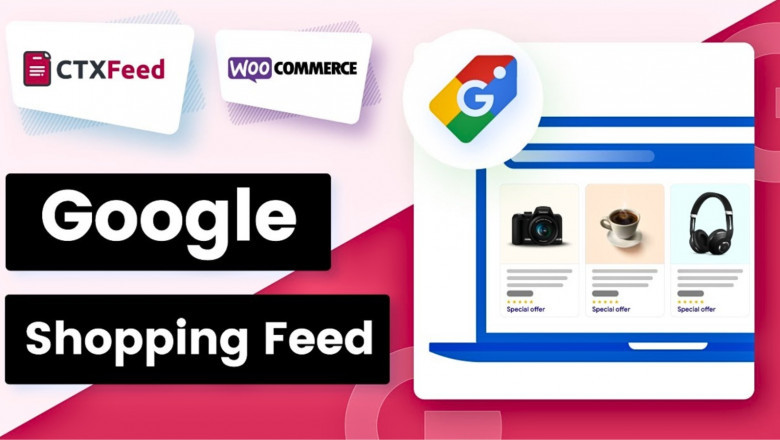views
Master Google Shopping Feed to Boost eCommerce Growth
Introduction:
In today’s competitive eCommerce world, just listing your products online isn't enough. To truly stand out and drive sales, you need to be visible where your customers are searching—and that means mastering the Google Shopping Feed.
Whether you're an online retailer or a digital marketer, understanding how to optimize and automate your Google Shopping product feed can dramatically increase your product visibility, click-through rates, and ultimately, conversions. This article will walk you through everything from the basics to advanced feed optimization strategies, focusing on product titles, automation, and apps.
What Is a Google Shopping Feed?
A Google Shopping Feed is a data file that contains detailed information about your products—such as titles, descriptions, prices, images, and availability. This feed is submitted to Google Merchant Center, where it connects to your Google Ads account, enabling your products to be shown in Google Shopping results.
Google uses this structured data to match your products to relevant search queries. So, if your feed isn't properly optimized, your products may never appear in front of potential customers, no matter how great they are.
Importance of a Well-Structured Google Shopping Product Feed
The structure of your Google Shopping product feed is the foundation of any successful campaign. It needs to be complete, accurate, and constantly updated to ensure that your products meet Google’s strict requirements.
Here are the essential components of a high-quality product feed:
-
Product Title
-
Description
-
Product Type and Google Product Category
-
Price and Availability
-
Brand, GTIN, or MPN
-
Product URL and Image Link
The more detailed and compliant your feed, the more likely your ads will appear in relevant searches.
Google Shopping Feed Optimization: Why It Matters
Optimizing your feed is not a one-time task—it’s an ongoing process. Google Shopping feed optimization involves refining each data point to ensure your products perform better in Shopping ads.
Here’s how optimization impacts your campaign:
-
Better Visibility: Optimized feeds are more relevant to search queries, increasing impressions.
-
Higher CTRs: Accurate titles and rich images draw more clicks.
-
Improved ROAS: Better targeting leads to better conversion rates and lower cost per click.
If you skip optimization, you’re leaving money on the table.
The Secret to Success: Google Shopping Product Title Optimization
Of all the attributes in your feed, the product title has the biggest impact. Google uses the product title to understand what you're selling and to decide whether it matches a user's search.
Effective Google Shopping product title optimization includes:
-
Front-loading keywords (the most important terms should appear first)
-
Including brand, color, size, and model numbers
-
Avoiding promotional language like “Best” or “Free Shipping”
For example:
❌ “Stylish Running Shoes”
✅ “Nike Men’s Air Zoom Pegasus 39 Running Shoes – Size 10 – Black”
Titles like the second example are more specific and keyword-rich, making them more likely to appear in relevant searches.
Google Shopping Title Optimization Strategies That Work
When it comes to Google Shopping title optimization, you must align with how customers search. Use keyword tools to discover high-volume search terms and implement them naturally into your titles.
Other tips include:
-
Following a consistent format across all titles
-
Avoiding all caps and unnecessary punctuation
-
Using dynamic keyword insertion tools if you have a large inventory
-
A/B testing different title formats to find what works best
Optimized titles help Google understand your product—and help your audience click faster.
Automating Google Shopping Feed Management
Managing product data manually is difficult, especially as your inventory grows. That’s why Google Shopping Feed Automation is critical.
Automation tools allow you to:
-
Sync your feed directly with your eCommerce platform (Shopify, WooCommerce, BigCommerce, etc.)
-
Automatically update prices, stock, and availability
-
Apply rules and templates to dynamically update titles and descriptions
-
Schedule daily or real-time feed uploads to Google Merchant Center
Feed automation not only saves time—it ensures your feed is always accurate and aligned with your store’s backend.
Choosing the Right Google Shopping Feed Apps
To simplify automation and optimization, many merchants rely on Google Shopping Feed apps. These tools connect directly to your store and offer intuitive dashboards for managing and improving your product feed.
Popular apps include:
-
Simprosys Google Shopping Feed: Offers dynamic feed optimization and seamless integration with Google Merchant Center.
-
Feedonomics: Ideal for larger enterprises that need advanced control.
-
ShoppingFeeder: Great for multi-channel campaigns beyond Google.
These apps offer bulk editing tools, automatic error detection, and built-in title optimization features—making them invaluable for serious sellers.
Common Google Shopping Feed Mistakes (And Fixes)
Even seasoned sellers make mistakes that can hurt shopping ad performance. Common issues include:
-
Missing GTINs or brand names
-
Poor-quality or incorrect images
-
Misleading titles or clickbait
-
Duplicate product listings
-
Out-of-date pricing or availability
To fix these, regularly audit your feed using Google Merchant Center diagnostics and use feed apps to apply automated rules and alerts.
Staying Ahead: Ongoing Google Shopping Feed Optimization
Google updates its Shopping policies and best practices frequently. Staying ahead means regularly refining your:
-
Product titles (based on trending search behavior)
-
Categories and attributes (based on Google’s taxonomy updates)
-
Seasonal campaigns (like back-to-school, holidays, etc.)
-
Performance metrics (clicks, impressions, conversions)
Feed optimization isn’t a “set it and forget it” task—it’s a performance lever you should adjust constantly for continued growth.
Conclusion: Elevate Sales with Smart Feed Strategy
A powerful Google Shopping Feed is more than a technical requirement—it's the backbone of your Shopping ads strategy. Through well-structured data, precise product title optimization, and smart use of feed automation tools, you can ensure your products are discovered by the right audience at the right time.
Investing in your feed means investing in your visibility, traffic, and long-term eCommerce success. Don’t let a poorly optimized feed hold your business back. Take action today, and watch your conversions grow tomorrow.














Comments
0 comment